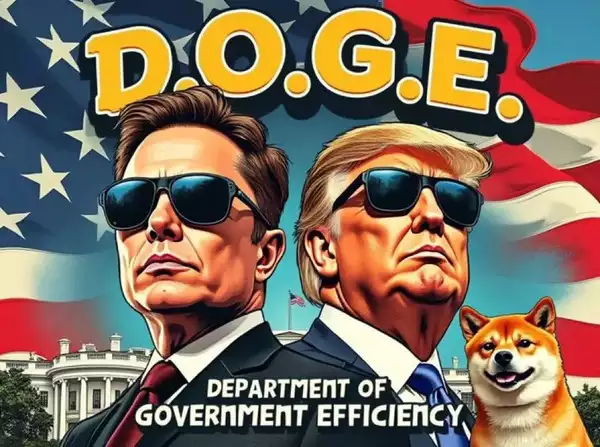In an uncanny reflection of Yes Minister’s satire, the new US Department of Government Efficiency, or DOGE, sounds straight out of the Ministry for Administrative Affairs—a fictional British institution infamous for its comically circular logic and dedication to preserving inefficiency. Yes Minister, the 1980s British TV show, followed the bumbling Minister Jim Hacker as he grappled with a bureaucratic machine designed to self-preserve rather than reform. With the Department of Government Efficiency, a real-life version of Hacker’s Ministry may have come to the US, as DOGE aims to dismantle inefficiency, echoing the same paradox that Yes Minister once lampooned.
Humphreys’ Introduction – Yes Minister
In Yes Minister, bureaucracy isn’t just a system; it’s a labyrinth engineered to perpetuate itself. The civil servants, led by Sir Humphrey Appleby, expertly stonewall any attempt at change, wielding obscure regulations and jargon as weapons. Similarly, DOGE, spearheaded by Elon Musk and Vivek Ramaswamy, is set to streamline government. Yet, like Hacker’s ministry, DOGE faces a government machine skilled in red tape and averse to rapid change. DOGE’s task—applying startup efficiency to a complex bureaucracy—is an audacious “Manhattan Project” in its own right.
The project even takes inspiration from Musk’s favourite cryptocurrency, Dogecoin, which started as a joke but has since symbolised unpredictable innovation. Here, the joke coin has turned into a real-world mission. Much like Jim Hacker’s naïve belief in swift reform, DOGE operates under a bold vision: dismantling the very inefficiencies that protect Washington’s institutions. But, as with Yes Minister, this mission may reveal that bureaucratic inertia isn’t easily overcome, leaving Musk and Ramaswamy facing the same slow gears that ground down Hacker’s plans. In a case of reel becoming reality, DOGE is set to be both an ambitious experiment and a test of whether real reform can outwit the entrenched system.
What is DOGE?

The Department of Government Efficiency (DOGE) has been introduced by President-elect Donald Trump with an aim to “drain the swamp” by attacking Washington’s infamous bureaucracy head-on. DOGE brings together Elon Musk and Vivek Ramaswamy, each with a reputation for unorthodox approaches and a deep-seated aversion to waste. DOGE’s mission is sweeping: reduce federal spending, overhaul government operations, and make the bureaucracy lean and transparent. The bold tagline for DOGE is Musk’s own phrase, “Government 2.0,” hinting at a tech-inspired revamp that seeks to streamline operations, improve service delivery, and cut down costs.
DOGE aims to eliminate redundant departments, collapse overlapping agency functions, and integrate automation to make government processes more efficient. Musk, a known proponent of rapid innovation, sees DOGE as a proving ground for applying private-sector principles, such as rapid iteration and lean management, to the slow-moving gears of federal government. He likens it to a “public sector startup,” where cost-effectiveness and speed are paramount.
Ramaswamy, on the other hand, brings a pragmatic approach, calling for cost-benefit analyses on every policy to justify taxpayer expenses. One of his key proposals is to introduce performance metrics for government employees, ensuring accountability at all levels. His philosophy aligns with Musk’s, focusing on achieving “return on taxpayer investment” with every initiative DOGE undertakes.
To that end, DOGE has outlined several ambitious targets:
Trillion-Dollar Savings Plan: DOGE has proposed a bold objective of cutting $2 trillion from the federal budget over the next five years. This would involve scaling down several programs that Musk and Ramaswamy argue have become bloated and redundant, while focusing on essential services with maximum public impact. Savings will supposedly come from digitisation and merging duplicate functions across departments.
AI and Automation in Government: One of DOGE’s flagship proposals is to implement AI and automation in low-skill, high-volume government tasks. According to Musk, even a 10% increase in productivity through automation could result in billions in savings. Areas like data entry, administrative filings, and processing of government forms are ripe for AI-driven improvement.
Decentralising Agencies and Operations: DOGE is also exploring the decentralisation of government agencies, potentially relocating non-essential operations outside of Washington, DC. This would not only cut costs associated with maintaining operations in the capital but would also bring federal jobs and investments to economically underdeveloped regions across the US, a move Ramaswamy has described as “democratizing government access.”
‘Hackathons for Policy’: Musk and Ramaswamy plan to introduce a series of “hackathons” where private-sector innovators collaborate to develop new policy ideas and solutions for DOGE. Each hackathon will focus on one of Washington’s most infamous inefficiencies, such as the Social Security processing backlog or the Department of Veterans Affairs waitlist issues. These events are intended to harness Silicon Valley-style problem-solving and bring fresh perspectives to old problems.
Transparency Initiative: DOGE is promising a transparency overhaul, where, in Musk’s words, “everything is on the blockchain.” By employing blockchain technology, DOGE aims to make government spending data public and tamper-proof, a bold move to win public trust and reduce corruption. Each department would have a transparent ledger of spending accessible by taxpayers, reflecting DOGE’s motto of “nothing to hide, nowhere to hide.”
DOGE’s critics, however, argue that such sweeping changes could face immense resistance from an established bureaucratic machine. As Yes Minister’s Sir Humphrey Appleby would attest, civil servants often wield quiet power, capable of delaying, complicating, or outright nullifying attempts at reform. In this sense, DOGE’s goal of revolutionising Washington faces not just the challenges of scale but also entrenched opposition from within.
Nevertheless, Musk and Ramaswamy are undeterred, casting DOGE as a last-resort attempt to reclaim government efficiency. Much like the fictional Ministry for Administrative Affairs, DOGE operates in a world where paradoxes abound: a department created to reduce departments, a budget-cutting office that costs millions, and a transparency promise that may get bogged down in legal red tape. Yet, if DOGE succeeds, it could set a precedent, becoming a global model for how governments can embrace tech-inspired transformation—no longer the punchline but the blueprint for administrative evolution.
